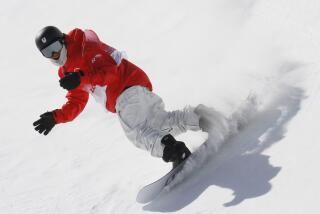The chill factor
- Share via
You’re several miles into a winter hike in the mountains when a breeze starts to kick up. The day started out sunny and warm, so you’re wearing only a cotton T-shirt and hiking pants. You’ve worked up a sweat and now the wind is howling.
Suddenly you’re shivering. This is the body’s attempt to generate heat. Fingers will stiffen as your body decreases blood flow to the extremities and concentrates instead on warming the core organs -- lungs, heart and brain -- which will become severely distressed if they get too cold.
At that point, you had better turn around -- because hypothermia probably has already struck.
Hypothermia occurs when you lose heat faster than you produce it. The body works best at about 98 degrees. When your core temperature falls below 95, it’s considered a medical emergency, according to the national Centers for Disease Control and Prevention. As hypothermia worsens, blood flow is reduced, pulse rate decreases and eventually, the heart stops.
For all that’s written about climbing mishaps, ski accidents and bear maulings, hypothermia remains a top killer of people who actively engage in the outdoors.
The temperature outdoors doesn’t have to be subfreezing for hypothermia to occur, according to the CDC. A person can become chilled and vulnerable to hypothermia even when outside temperatures are in the 40s.
“One of the insidious things about hypothermia is that you may not even sense you’re getting cold,” says Todd Schimelpfenig, curriculum director for the Wilderness Medicine Institute at the National Outdoor Leadership School in Lander, Wyo.
As the body’s temperature lowers, things quickly start to malfunction -- including our nerve center, the brain.
“Early on, people’s mental status deteriorates,” says Schimelpfenig. “You shiver, your fingers get stiff and clumsy, and things get problematic. You can’t get the stove started or light a fire, can’t zip up a jacket.”
Because of decreasing mental functioning, victims often fail to recognize their symptoms.
“That’s why having a buddy and watching out for each other is so critical,” Schimelpfenig says.
One sign to watch for is a normally affable hiking companion who starts to get grumpy. Hypothermia is often identified when someone shows signs of the “umbles”: stumbles, mumbles, fumbles and grumbles, says Rick Curtis, director of Princeton University’s Outdoor Action program, which conducts classes in outdoor education.
The “umbles” indicate changes in motor coordination and should not be ignored. If left untreated, shivering can become uncontrollable, speech may become slurred and the victim may even fall. The shivering eventually stops -- when the body shuts down.
Luckily, the condition is almost entirely preventable. This begins with proper protection from the elements. Unlike wolves that have thick layers of fur, humans aren’t naturally equipped for cold weather.
A layer of underfur insulates canis lupus in winter. Hollow outer hairs trap warmth and repel rain and snow. When it becomes windy, lobo curls up and wraps its bushy tail around itself, covering its face.
Layers of clothing can serve as humans’ faux fur to protect against hypothermia.
For the layer closest to the skin, a synthetic such as polypropylene wicks away perspiration. The next layer should be a heavier synthetic, such as fleece, to trap warmth close to the body. The outer layer should be a waterproof, breathable shell that vents perspiration but keeps out wind and rain.
And bring a hat -- an unprotected head accounts for more than half the body’s heat loss.
Keeping dry equals staying alive. That’s why many outdoors people shun cotton, which loses its ability to insulate when wet.
According to “The Freedom of the Hills,” the bible of the Seattle-based Mountaineers outdoor organization, wet garments in contact with skin draw away 25 times more heat than dry ones.
On cold days, eating high-calorie, high-carbohydrate food and staying well-hydrated also are important to keeping yourself warm. Don’t rely on snow to quench your thirst; it provides little water and can lower your body’s core temperature.
Get back to civilization quickly if you or a buddy are becoming hypothermic. The victim should be given something warm to drink, and any wet clothes should be replaced by dry ones.
Prevention is the key. Says Schimelpfenig: “One message we give people is that it’s much easier to stay warm than to get warmer.”
To e-mail Julie Sheer or read her previous Outdoors Institute columns, go to latimes.com/juliesheer.

